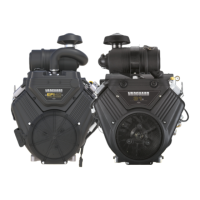Troubleshooting - Starter Motor
If a starting problem is encountered, check the engine to eliminate it as the cause of the problem. Check the engine for
freedom of rotation by removing the spark plugs and turning the crankshaft over slowly by hand.
Starter Motor Troubleshooting
Starter Motor Troubleshooting Guide
Problem Potential Cause Action
Additional load affecting performance Reduce load on engine and retest
Faulty electrical connection (battery circuit) Test electrical connections and wiring
Discharged battery (see also the alternator
as a possible cause of discharged battery)
Test battery and test alternator and regulator. See
Testing the Battery and Testing Alternator Output
Dirty or worn starter motor commutator,
bearing, weak magnets, etc.
Replace starter motor
Worn brushes or weak brush spring Replace starter motor
Wrong oil viscosity Replace engine oil with
recommended specification
Battery leads too long or wire too small Test and replace, if necessary, battery leads
Engine Cranks Slowly
Battery too small Replace battery with recommended specification
Faulty safety interlocks Test safety interlocks. Replace as necessary
Discharged or defective battery Test battery. See Testing the
Battery. Replace as necessary
Faulty electrical connections Test electrical connections and wiring.
Clean, repair, or replace as necessary
Faulty starter motor switch (open circuit) Test switch. Replace as necessary
Open circuit in starter motor Replace starter motor
Brushes sticking, etc. Replace starter motor
Engine Will Not Crank
Faulty solenoid Replace solenoid. See SECTION 6 -
SERVICE ENGINE SUBASSEMBLIES
- Starter Motor Solenoid
Sticking pinion gear due to dirt Clean pinion gear
Damaged pinion or ring gear Replace starter motor or flywheel
Starter clutch slipping Replace starter motor
Starter Motor Spins But
Does Not Crank Engine
Reverse rotation due to incorrect
motor polarity – all motors rotate
counterclockwise viewed from pinion gear
Replace starter motor
Defective starter switch Test switch. Replace as necessaryStarter Motor Spins But Does Not Stop
Defective starter solenoid Replace solenoid. See SECTION 6 -
SERVICE ENGINE SUBASSEMBLIES
- Starter Motor Solenoid
Starter Motor SolenoidContinuity Test
The starter solenoid is a normally open, electrically activated
switch. When the key switch is turned to the START position,
the switch closes, allowing battery current to flow to the
starter motor and crank the engine.
The solenoid may be tested while mounted on engine.
1. Obtain a digital multimeter and a jumper test lead.
2. Remove POSITIVE battery cable from battery. Remove
battery cable from stud terminal on solenoid.
3. Disconnect YELLOW wire from the CONTROL CIRCUIT
terminal (C, Figure 29)on the solenoid.
4. Key switch must be in OFF position.
5. Insert RED multimeter test lead into the volt and ohm
receptacle.
6. Insert BLACK test lead into COM receptacle in meter.
7. Rotate meter selector to Diode Test position.
8. Attach one meter test lead to each stud terminal on
solenoid.
9. Attach one end of jumper lead to POSITIVE terminal on
battery.
10. Touch jumper wire to the CONTROL CIRCUIT terminal
on solenoid.
An audible "CLICK" should be heard as the solenoid
switch closes. The multimeter should indicate continuity.
If the starter motor fails to crank the engine, proceed to
Starter Motor Solenoid Voltage Test in this section.
If the solenoid does NOT "click" or the multimeter
indicates NO continuity, replace starter solenoid. See
SECTION 6 - SERVICE ENGINE SUBASSEMBLIES -
Starter Motor Solenoid.
43

